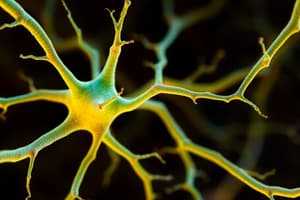Podcast
Questions and Answers
What does the term communication originate from?
What does the term communication originate from?
Latin word 'communicare'
Which of the following is NOT a function of communication?
Which of the following is NOT a function of communication?
- Social Interaction
- Information Dissemination
- Emotion Suppression (correct)
- Control/Regulation
The process of communication involves a sender, a message, and a receiver.
The process of communication involves a sender, a message, and a receiver.
True (A)
What is the role of feedback in the communication process?
What is the role of feedback in the communication process?
What is a locution in speech acts?
What is a locution in speech acts?
Which model of communication was designed originally for telephone/cell phone communication?
Which model of communication was designed originally for telephone/cell phone communication?
The process by which a sender converts ideas into understandable messages is called ______.
The process by which a sender converts ideas into understandable messages is called ______.
Match the following types of noise with their examples:
Match the following types of noise with their examples:
Flashcards are hidden until you start studying
Study Notes
Function and Nature of Communication
- Origin of the word “communication” is from the Latin "communicare," meaning to make common.
- Communication involves sending and receiving information between individuals or groups, influenced by situational needs.
- Definition encompasses sharing messages across various channels, contexts, media, and cultures.
Functions of Communication
- Control/Regulation: Directs behavior, exemplified by doctor prescriptions or parental guidance.
- Social Interaction: Facilitates connections, such as making friends or family interactions.
- Information Dissemination: Educates by providing important knowledge, seen in weather forecasts or educational discussions.
- Motivation: Inspires better performance and personal growth through encouragement and positive reinforcements.
- Emotional Expression: Allows expression of feelings and emotions, contributing to personal connections.
Key Points on Speaking Functions
- Speaking regulates behavior by following orders or instructions.
- Used for social interaction, emphasizing clarity and purpose in conversations.
- Motivates individuals to express feelings, utilizing language that conveys various emotions.
Speech Acts
- Defined as utterances serving specific functions in communication, impacting the world.
- Locution: The act of saying something, e.g., "Hello!"
- Illocution: The intention behind the utterance; for example, greeting someone signifies socialization.
- Perlocution: The effect of the utterance on others, which may differ from the speaker's intentions.
Models of Communication
- Elements of Communication Process:
- Sender: Initiator of the message.
- Receiver: The target of the message.
- Message: The content shared.
- Channel/Medium: The method of communication (e.g., face-to-face, digital).
- Feedback: The receiver's response to the message.
- Encoding: Converting ideas into understandable messages by the sender.
- Decoding: Interpretative process by which the receiver makes sense of the message.
- Noise: Anything that disrupts communication; may include physical, psychological, or physiological barriers.
Linear Model of Communication
- Aristotle’s Model: Focuses on public speaking; emphasizes tailoring speeches for different audiences and occasions.
- Shannon-Weaver Model: Developed for telephone communication; originally lacked feedback.
- Norbert Wiener introduced feedback, transforming it from a linear to a cyclical model.
Types of Noise
- Physical Noise: External factors disrupting communication, like loud sounds or distractions.
- Psychological Noise: Intrusive thoughts or mental blocks affecting communication engagement.
- Physiological Noise: Physical conditions impacting understanding, such as fatigue or illness.
Studying That Suits You
Use AI to generate personalized quizzes and flashcards to suit your learning preferences.




